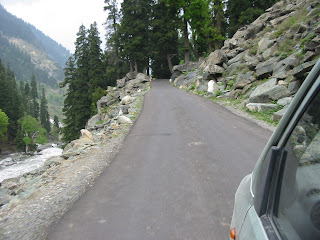The Inner Kora of Mt Kailash parikrama involves trekking for about 28 km. Not all the K-M yAtris attempt this parikrama.
(This is simply a digital attempt, courtesy Google Earth)
 |
| Closer view of Mt Kailash |
 |
| Schematic of the KM routes (Source: National Geographic Adventure magazine) |
 |
| Inner kora |
Here's a description of the Inner Kora (
Source Update: not available as of Jun 2014)
"Inner Kora - Ganesh Ling / Atma Ling
... the last day of our yatra we go back to Astapad. We will next visit the base of Mt Kailash and touch the Lords feet. We will also visit a place called Saptarishi caves inside Kailash and later complete a parikrama of Nandi parvat. This segment of the yatra is also referred to as Inner Kora. We have to do this trek only on foot.
This journey s extremely special. We get a changing darshan of the lord as we get closer and closer to him. Just the feeling that we are nearing the Lord generates a great energy in us.
The experience of this approach to Kailash is indescribable. At close quarters we once again admire the majesty and magnificence of Mt Kailash. At one stage we can no more see either the Top or Base of Mt Kailash. We continue to proceed to the feet of the Lord.
This place is called Ganesh Ling. It is formed by ice particles sliding down from Mt Kailash and collecting here. At times, pieces of rock which were originally part of Kailash also get dragged alongwith the ice. These small rock pieces are referred to Atma ling and considered extremely divine. We complete our 11th abisheka puja for the Lord in this place.
..........
Inner Kora - Saptarishi Caves
Next we visit Saptharishi caves which is almost like a balcony on the face of Kailash at a height of 70 – 80 metres from the base. The Tribetans have constructed small structures here for their deities.
On reaching Saptharishi caves we are inside kailasha and have merged with the Lord. Whereever we touch is Kailash. Words fail us at the extreme grace that the Lord has showered on ordinary people like us. Goddess Parvathi is praised as one who is kind even to the undeserving. We break into tears of gratitude at the lord for this gift for which even devas and rishis long for in many births.
We next attempt a prayer to the lord with the little knowledge he has given us. This is also a suitable spot to recite the Soundaryalahiri. It is on these very walls that Lord Shiva had composed 100 poems in praise of Goddess parvathi. When Adi Shankara visited Kailash he had colleced these poems from the walls of Kailash. However Nandi deva took away his notes as these are secrets of Kailash. However with his great memory Adi Shankara recollected 41 of these slokas as Ananda Lahiri and composed the next 59 verses as Soundarya lahiri, all describing the beauty and worship methods of Goddess Parvathi.
With a most reluctant heart we bid adieu to this place and proceed for our parikrama of Nandi Parvat. We arrive at a point between Kailash and Nandi called Serdung Chuksum. At 19,400 ft this is the highest point of our yatra. We soak in the atmosphere of this place and as we look up we see the merciful eyes of the lord bestowing his grave on us. This darshan is really hypnotic and we lose all sense of our identity. Tears roll down our face and we repeatedly prostrate to the Lord.
We climb down the steep slope of Nandi from the right side and complete the Nandi Parikrama. We get excellent views of the pedestal of Lord Shiva. We also get a side view of the beautiful face of Goddess Parvathi.
We take a short deviation from our route to Astapad and visit two small ponds namely Tso Kapala and Tso Kavali. From here we collect the Kapala teerth and the alluvial soil as the Vibhuti Prasad of this area. We then reach Astapad by evening."




An excellent post with fantastic information.Loved it. It is in reality a nice and useful piece of info. I'm glad that you simply shared this helpful information with us. Please keep us informed like this. Thank you for sharing.
ReplyDeleteThanks,
Mount Kailash | Kailash Mansarovar 2012 | Kailash Mansarovar Tour | Kailash Yatra